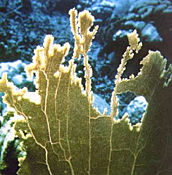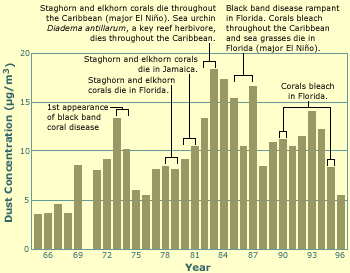AirPollution: Difference between revisions
No edit summary |
|||
| Line 34: | Line 34: | ||
This data was gathered from Joe Prospero at the University of Miami. <ref name="dd"></ref> | This data was gathered from Joe Prospero at the University of Miami. <ref name="dd"></ref> | ||
# | ##Causes and Effects | ||
*In the 1970's when a peak in dust pollution was observed in the Caribbean, the Sahel region of Africa was experiencing extreme drought conditions compounded by overgrazing and the drying of Lake Chad<ref name="dd"></ref>. Other possible factors contributing to this episode include global climate change, changes in regional meteorology, and local human activities. Human activities such as burning fossil fuels, burning garbage, and spraying pesticides account for many of the toxins found in dust pollution<ref name="aa"></ref>. Pesticides are a primary concern as they can interfere with animal reproduction, fertilization and immune function. Furthermore, two specific insecticides "chloropyrifos" and "endosulfan" are associated with preventing coral larvae to settle and reproduce<ref name="bb"><Handwerk, Brian. "Tainted African Dust Clouds Harm U.S., Caribbean Reefs." National Geographic News. 14 July 2008. Web. 23 Feb. 2015. Retrieved from http://news.nationalgeographic.com/news/2008/07/080714-africa-clouds.html.</ref>. The inorganic dust particulates are made of clay with gypsum and iron oxides that acts as a sponge to absorb other microorganisms <ref name="aa"></ref> These particles can carry elements such as nitrogen and sulfur that can have harmful affects on surface waters, marine environments, and vegetation. In the Virgin Islands, vegetation has adapted to low nitrogen levels meaning that there could be serious impacts if an abundance of nitrogen is introduced. Sulfur and nitrogen also increase the acidity of water which could also lead to coral bleaching and death <ref name="cc">"Air Pollution Impacts: Virgin Islands National Park." National Park Service. 15 Jan. 2015. Web. 23 Feb. 2015. Retrieved from http://www.nature.nps.gov/air/Permits/aris/viis/impacts.cfm</ref>. | *In the 1970's when a peak in dust pollution was observed in the Caribbean, the Sahel region of Africa was experiencing extreme drought conditions compounded by overgrazing and the drying of Lake Chad<ref name="dd"></ref>. Other possible factors contributing to this episode include global climate change, changes in regional meteorology, and local human activities. Human activities such as burning fossil fuels, burning garbage, and spraying pesticides account for many of the toxins found in dust pollution<ref name="aa"></ref>. Pesticides are a primary concern as they can interfere with animal reproduction, fertilization and immune function. Furthermore, two specific insecticides "chloropyrifos" and "endosulfan" are associated with preventing coral larvae to settle and reproduce<ref name="bb"><Handwerk, Brian. "Tainted African Dust Clouds Harm U.S., Caribbean Reefs." National Geographic News. 14 July 2008. Web. 23 Feb. 2015. Retrieved from http://news.nationalgeographic.com/news/2008/07/080714-africa-clouds.html.</ref>. The inorganic dust particulates are made of clay with gypsum and iron oxides that acts as a sponge to absorb other microorganisms <ref name="aa"></ref> These particles can carry elements such as nitrogen and sulfur that can have harmful affects on surface waters, marine environments, and vegetation. In the Virgin Islands, vegetation has adapted to low nitrogen levels meaning that there could be serious impacts if an abundance of nitrogen is introduced. Sulfur and nitrogen also increase the acidity of water which could also lead to coral bleaching and death <ref name="cc">"Air Pollution Impacts: Virgin Islands National Park." National Park Service. 15 Jan. 2015. Web. 23 Feb. 2015. Retrieved from http://www.nature.nps.gov/air/Permits/aris/viis/impacts.cfm</ref>. | ||
#Current Studies | #Current Studies | ||
Revision as of 11:30, 22 April 2015
Air Pollution, including dust
The effects of air pollution on coral reefs are getting more and more attention over the decades, as the serious threats caused by air pollution to the world's coral reefs are now widely recognized by scientists. It is important to understand how corals are in risks because of air pollution.
Source of Pollution
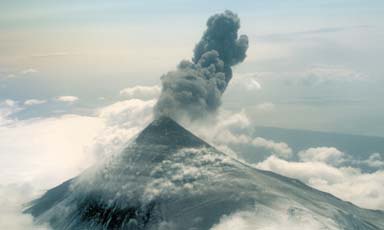
Generally, air pollution is any substance that people introduce into the atmosphere that has damaging effects on living things and the environment[1].
Both human activities and natural processes can create air pollution.
There are various sources of human-related air pollution. Major sources include:
- industrial waste gas composed of smoke, sulfides, nitrides, organic compounds, halides, carbides, etc.
- vehicle exhaust composed of carbon monoxide, sulfur dioxide, nitric oxides, and hydrocarbon as a result of burning fuels
- other pollutants created in human’s daily life, such as CFCs, ozone, and so on.
Some natural processes are also responsible for the air pollution. One major source of natural air pollution is the volcanic activities, where tons of pollutants including carbon dioxide, sulfuric oxides, and macro-particles are ejected into the atmosphere by volcanoes. Wildfires, desertification and emission of methane by animals are also major sources of the pollution.
Impacts of Pollution
How will the air pollution effect the coral reefs in the ocean?
- The fine airborne particles, or aerosols, can scatter incoming sunlight and create cloudier, more reflective conditions[2]. These macro-particles floating in the air can reduce the amount of sunlight reaching the sea surface in a large scale. And if the amount of aerosols is too large, the haze may form and block even more sunlight. As a result, the photosynthesis of the single-celled algae, zooxanthellae, which keeps a symbiotic relation with coral, will reduce sharply. Thus, the amount of nutrition the coral can obtain from zooxanthellae in order for its growth will reduce. As less sunlight reaches the sea, the water temperature will fall, worsening the situation even more. The growth rate of coral will be limited due to the insufficient sunlight and the cold water temperature. Coral bleaching, a process caused by the expulsion of zooxanthellae, will occur if the water gets too cold, possibly leaving the coral to death[3].
- Global warming is another big threat to coral reefs. The rapid buildup of greenhouse gases (GHGs) in the atmosphere during the past centuries has brought significant contribution to the climate change in the world. As the climate gets hotter, the rising water temperature of ocean will cause large scale of coral bleaching. Massive corals will die as a result of the change of climate. The increasingly frequent extreme weathers and disasters such as hurricanes and tropical storms due to the change of climate and rise of water temperature will bring direct physical damages to coral reefs. Rising sea level due to global warming will make the situation even worse[3].
- It is reported that, many serious coral diseases are also related to air pollution. Scientists have found that many pathogens will travel with the aerosols and spread over the world. One example is the African dust traveled with wind from deserts in Africa. Every year, several hundred million tons of African dusts are transported across the Atlantic to the Caribbean, Central and South America[4]. Pathogens like fungus Aspergillus sydowii, which causes the sea-fan diseases, and sphingomonas, which is the cause of white plague, can travel with the dusts and move to the other side of the earth, causing catastrophic problems to local corals[5].
- Air pollution is also responsible for ocean acidification. Ocean water normally contains carbonic acid because carbon dioxide in the atmosphere can be dissolved by the water. However, if the amount of carbon dioxide continues to increase, the chemistry of ocean water will be altered as the water contains more carbonic acid. As the water becomes more acidic, the amount of aragonite -- a mineral used by corals in reef building -- in the water will decrease and the ability of corals to build reefs by laying down their limestone skeletons will also be limited. Thus, the reversal of reef building will slow down and the loss of reef in the future may be a result[3].
Effects of African Dust on Coral Reefs
- Background Information
- Dust pollution is an issue that initially appeared and peaked in the 1970's, an initial hypothesis was that African dust pollution was correlated to coral and marine animal mortality rates [6] This dust is known to travel from the Sahara and Sahel of Africa and is composed of a variety of chemical contaminants, such as pesticides, and various organisms [7]. The 1970's marked the beginning of a period of extensive research into the effects of African Dust Pollution when atmospheric chemist Joe Prospero from the University of Miami graphed and found a correlation between dust concentration and a decline in marine species. The figure below shows that black band coral disease was first introduced in 1973 followed by mortality of Staghorn and Elkhorn coral beginning in 1978 followed by a rising mortality in sea urchins and ultimately a rise in coral bleaching. The graph shows illustrates that these events are marked by times of high dust concentration but it has not been proved if dust is actually the cause.
This data was gathered from Joe Prospero at the University of Miami. [6]
- Causes and Effects
- In the 1970's when a peak in dust pollution was observed in the Caribbean, the Sahel region of Africa was experiencing extreme drought conditions compounded by overgrazing and the drying of Lake Chad[6]. Other possible factors contributing to this episode include global climate change, changes in regional meteorology, and local human activities. Human activities such as burning fossil fuels, burning garbage, and spraying pesticides account for many of the toxins found in dust pollution[7]. Pesticides are a primary concern as they can interfere with animal reproduction, fertilization and immune function. Furthermore, two specific insecticides "chloropyrifos" and "endosulfan" are associated with preventing coral larvae to settle and reproduce[8]. The inorganic dust particulates are made of clay with gypsum and iron oxides that acts as a sponge to absorb other microorganisms [7] These particles can carry elements such as nitrogen and sulfur that can have harmful affects on surface waters, marine environments, and vegetation. In the Virgin Islands, vegetation has adapted to low nitrogen levels meaning that there could be serious impacts if an abundance of nitrogen is introduced. Sulfur and nitrogen also increase the acidity of water which could also lead to coral bleaching and death [9].
- Current Studies
Studies are still being conducted to further investigate where hazardous dust particles are actually coming from as there isn't any exact proof whether the particles are local or foreign. Furthermore, it is also possible that the toxins may not have even come from Africa as the pollution gets mixed in from air all over the world, such as North America.
- The St. Petersburg Coastal and Marine Science Center has various test sites in the Southern Caribbean (Trinidad and Tobago), St. Croix U.S Virgin Island, and more northern areas [7]. These sites are collecting dust samples to compare the constituent particulates to those found in Africa.
Particulates
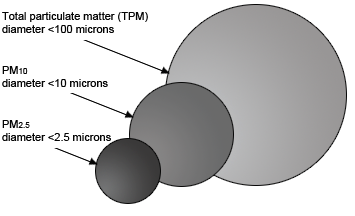 [10].
[10].
Particulate matter are small particles ranging from 2.5 micrometer to 10 micrometer in diameter. These particles can come from anywhere: smokestacks, car emissions, etc. [11].
• Farming, windstorms (dust), volcanic eruptions, industrial processes, burning of fossil fuels • Damages trees and crops, interferes with absorption of CO2 and O2 and transpiration, alters food chain, acid rain damages (dry deposition of SO2) For natural sources, can prevent erosion and loose soil by good farming techniques (i.e. no till agriculture) Particulates are a source of cloud nuclei that can increase cloud formations, thereby blocking out the sun from the water, depriving the zooxanthellae of the light needed for photosynthesis. There are natural and anthropogenic particles, the African Dust mentioned earlier are a natural source. Anthropogenic sources include outputs from any manmade sources, aerosols are a very common type of anthropogenic particulate. Aerosols and volcanoes: Aerosols emitted from coal (sulfates) and volcanic eruptions may contribute to global cooling, because sulfates act as seeding for clouds. The aerosol articles provide surfaces for water to condense on; cloud form and reflect incoming solar energy. The aerosol particles also reflect a significant amount of sunlight directly
Greenhouse gases
Ocean Acidification
 [12].
[12].
Greenhouse gases can cause both ocean acidification and coral bleaching.
Ocean acidification is caused by an excess of carbon dioxide emitted into the atmosphere. The extra CO2 will be absorbed by the ocean, and will react with the water to release a hydrogen ion, thus lowering the pH. The lowered pH will dissolve the calcium carbonate skeleton of the corals.
Coral bleaching occurs when zooxanthellae - the symbiont living within the corals and give them its color - are expelled due to increased heat of the ocean.
Coral Bleaching
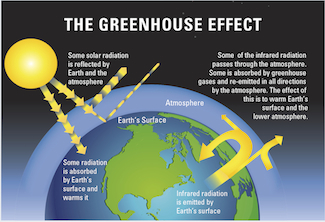 [13].
[13].
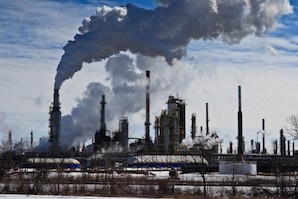 [14].
[14].
Solutions
Kyoto Protocol
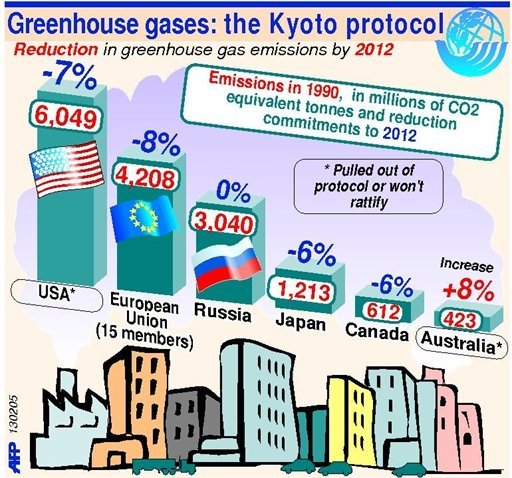 [10].
[10].
References
- ↑ "Air Pollution." National Geographic. N.p., n.d. Web. 13 Apr. 2014. Retrieved from http://environment.nationalgeographic.com/environment/global-warming/pollution-overview/
- ↑ Kwiatkowski, Lester. "Air Pollution Casts a Cloud over Coral Reef Growth." The Conversation. N.p., 8 Apr. 2013. Web. 16 Apr. 2014. Retrieved from http://theconversation.com/air-pollution-casts-a-cloud-over-coral-reef-growth-13319?utm_medium=email&utm_campaign=Latest+from+The+Conversation+for+9+April+2013&utm_content=Latest+from+The+Conversation+for+9+April+2013+CID_108dc635aa87df8ce801c5c3cc26a4cd&utm_source=campaign_monitor&utm_term=Air%20pollution%20casts%20a%20cloud%20over%20coral%20reef%20growth
- ↑ 3.0 3.1 3.2 Burke, Lauretta Marie., and Jonathan Maidens. Reefs at Risk in the Caribbean. Washington, D.C.: World Resources Institute, 2004. Print.
- ↑ "Asthma, Coral and African Dust." PBS. PBS, n.d. Web. 16 Apr. 2014. Retrieved from http://www.pbs.org/strangedays/episodes/onedegreefactor/experts/africandust.html
- ↑ Shinn, Eugene A., Garriet W. Smith, Joseph M. Prospero, Peter Betzer, Marshall L. Hayes, Virginia Garrison, and Richard T. Barber. "African Dust and the Demise of Caribbean Coral Reefs." Geophysical Research Letters 27.19 (2000): 3029. Print.
- ↑ 6.0 6.1 6.2 Shidmt, Laurie J. "When the Dust Settles." NASA Earth Observatory. 18 May 2001. Web. 23 Feb. 2015. Retrieved from http://earthobservatory.nasa.gov/Features/Dust/.
- ↑ 7.0 7.1 7.2 7.3 "The Effects of African Dust on Coral Reefs and Human Health." U.S Geological Survey. 15 April 2014. Web. 23 Feb. 2015. Retrieved from http://coastal.er.usgs.gov/african_dust/index.html.
- ↑ <Handwerk, Brian. "Tainted African Dust Clouds Harm U.S., Caribbean Reefs." National Geographic News. 14 July 2008. Web. 23 Feb. 2015. Retrieved from http://news.nationalgeographic.com/news/2008/07/080714-africa-clouds.html.
- ↑ "Air Pollution Impacts: Virgin Islands National Park." National Park Service. 15 Jan. 2015. Web. 23 Feb. 2015. Retrieved from http://www.nature.nps.gov/air/Permits/aris/viis/impacts.cfm
- ↑ 10.0 10.1 "Emission technology: Pollutants - Contaminants" Web. Apr. 2015. Retrieved from http://www.axces.eu/index.php?option=com_content&view=article&id=284&Itemid=528. Cite error: Invalid
<ref>tag; name "ii" defined multiple times with different content - ↑ "Basic Information" EPA. Environmental Protection Agency, Web. Apr. 2015. <http://www.epa.gov/pm/basic.html>.
- ↑ "Ocean Acidification: The Other Carbon Dioxide Problem" Web. Apr. 2015. Retrieved from http://www.pmel.noaa.gov/co2/story/Ocean+Acidification.
- ↑ "Climate Change at the National Academies" Web. Apr. 2015. Retrieved from https://nas-sites.org/americasclimatechoices/more-resources-on-climate-change/climate-change-evidence-and-causes/climate-change-evidence-and-causes-figure-gallery/figb1/.
- ↑ "World Meteorological Organization Reports Greenhouse Gas Emissions at a Record High" Web. Apr. 2015. Retrieved from http://inhabitat.com/world-meteorological-organization-reports-greenhouse-gas-emissions-at-a-record-high/.
